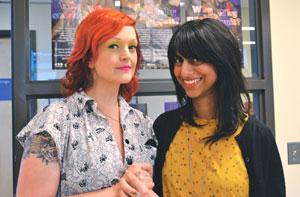
Natalia Saavedra, Sheila Sampath and Rocio Velasquez hard at work in The Public Studio. Credit: Carmen Cheung
Sheila Sampath went into commercial design knowing she was going to hate it. But in the end, she says, it all worked out because her program provided her with the tools to create The Public Studio, the lefty design company of her dreams.
From the clean lines in its office to its pink-and-white website, The Public looks kind of like your typical ad firm. But there’s one major difference: it “specializes in changing the world.” Even if you haven’t heard of it, you’re probably surrounded by its work.
Temporary tattoos promoting Pap tests for trans guys? A brightly coloured website about how to quit smoking? A photo campaign featuring a fabulous crew of queer South Asians? If not-for-profit design and PSAs have gotten remarkably more fun in this city, Sampath and The Public are the ones to thank.
The project was only an idea in the back of her head until Sampath realized that, after years of activism, she was burnt out. She wanted to focus her energy on creative campaigning — generating stickers, posters and design. So the activist-turned-entrepreneur developed a plan: go to design school, spend some time learning the ropes, and then use her experience to breathe new life into progressive projects and campaigns.
“With commercial design, you really try to capitalize on the things that people don’t know. So you’re kind of trying to trick them,” says Sampath, who first set up shop at home, as a freelancer for not-for-profit clients.
But she soon started getting a lot of work — and finding herself lonely. She picked up studio manager Rocio (Ro) Velasquez and designer Natalia Saavedra. They also work with Montreal designer Coco Riot and a Winnipeg web developer named Derek Hogue.
For Sampath, moving from the white-male-dominated world of commercial design to a team led by rad women of colour was a welcome change. “It’s crappy to be in a space where if you say something [about a problem with an ad] people say, ‘What are you? Are you some kind of feminist?’”
Velasquez, The Public’s studio manager, says because the studio’s team hails from diverse backgrounds, they’re able to make better campaigns.
She points to The Public’s work on a recent poster series about anti-bisexual stigma. “We can do all the research that we want, but people know their own experiences,” she says. The posters featured community members who didn’t fit into some people’s pigeonhole “diversity quotas” — from a pregnant woman to an older trans gentleman.
Velasquez says that because of their own experiences with oppression and activism (she identifies as mixed-race and indigenous to South America), members of the studio don’t tokenize people. “I feel like I carry 500 years of colonialism in my face, my hands, my body, every day,” she says. “That . . . really defines the work that I want to do.”
Sampath credits The Public’s success to an unusual business model. “We put our clients through the wringer,” she says. “Their agenda is our agenda as well. We’ve turned away work before because we’re like, ‘This place is sketchy and they’re trying to save Third World babies and I don’t like that!’”
But those relationships cut both ways. “Sometimes I have to, you know, rethink invoices . . . we have to be very patient,” Velasquez laughs. “Which is understandable, because we know that everyone’s stretched, especially in non-profit and community work.”
It is unusual to hear of a design studio retroactively giving a discount. But Velasquez says it’s the kind of empathy that allows workers at not-for-profits — already terrified of impending budget cuts — to give The Public their trust.
This flexibility allows the group to use design to educate and inform, not just sell products.
“That’s a really big difference between the corporate world and the not-for-profit world . . . [the] not-for-profit world is like, in panic mode,” Sampath says. “I don’t think we’re hit by the recession as much, but we’re hit by bad politics. We’re worried that our clients won’t exist in a year.”


 Why you can trust Xtra
Why you can trust Xtra


